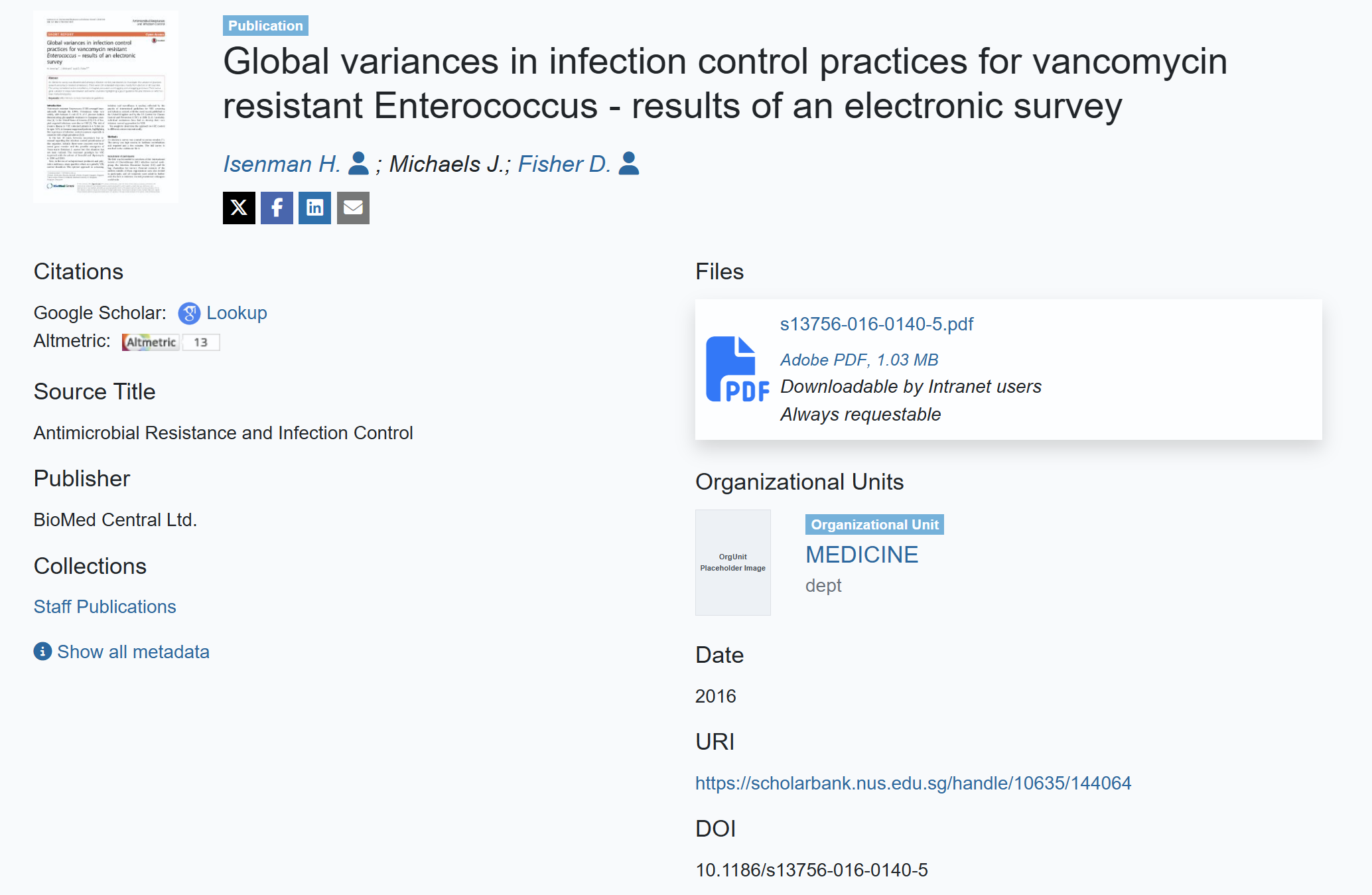
The Scholarly Communication team at NUS Libraries provides consultations to the NUS community on matters related to academic publishing, predatory publishing, Open Access and APCs, research impact metrics and how you can obtain your own metrics or profiles for Annual Reviews, P&T or peer benchmarking.
Do feel free to contact us if you have any questions:
Altmetrics has been defined as "the study and use of scholarly impact measures based on activity in online tools and environments" (Priem, 2012) The term is often used to describe any alternative, non-citation based measure of research impact, such as:
Altmetrics and are meant to complement, not replace, traditional measures of impact.
This page will highlight to you some sources of altmetrics that might be relevant to you.
Altmetric.com is a provider and aggregator of altmetrics information. They provide a free tool that allows you to quickly find out the altmetrics details of a paper or research output - the only requirement is that the bookmarklet can only work on research outputs that have a valid Digital Object Identifier (DOI)
You can learn more about the bookmarklet here - https://www.altmetric.com/solutions/free-tools/bookmarklet/

"Screenshot" from Altmetric by Altmetric Digital Science

"Screenshot" from Altmetric by Altmetric Digital Science
Article records on Dimensions provides alternative metrics such as policy, clinical trial, patent citations if they are available. In addition, clicking on the Altmetric donut will show other kinds of Altmetric-related attention, if available.
 “Screenshot” from Dimensions by Digital Science
“Screenshot” from Dimensions by Digital Science
You may refer to this other guide for more information on how to find articles on Dimensions
Altmetric tracks and captures a range of online attention sources to published research across social media, news outlets, policy and more. The results and outputs available in Altmetric are based on their data sources.
Go to Altmetric Explorer and make use of the search bar at the top by clicking on ‘Edit Search’. By default, the search shows all publications from National University of Singapore.

“Screenshot” from Altmetric by Digital Science
Their Advanced Search provides you with the ability to search across different research outputs. Some recommendations to start would be to either do a keyword, title, affiliation or ORCID search. Searching by “Verified Author” or “Verified Departments” will only bring results from NUS. You could also create a full list of publications based on their DOI or other scholarly identifiers and search for a group of publications at one go. Feel free to try out the other search options as well. Then click on ‘Run Search’.

“Screenshot” from Altmetric by Digital Science
An overview of your search results will be presented.

“Screenshot” from Altmetric by Digital Science
You could also click on ‘Research Outputs’ to look at the individual articles. Click on any title to go to the Altmetric Explorer record for that publication to analyze the article’s Altmetric mention in more detail.

“Screenshot” from Altmetric by Digital Science
The Altmetric detail page provides more details about the alternative metrics and mentions received by the research output.

“Screenshot” from Altmetric by Digital Science
An alternative way to use Altmetric is to browse by ‘My institution’ by clicking on the button on the left. This provides a view of authors and departments within NUS. Do note that browsing by ‘My institution’ only shows authors who have Elements profiles and their claimed publications. As such, the Altmetric available by authors and departments here is a rough proximation of their Altmetric attention; a more thorough search on Altmetric using DOI or advanced search will pull out more accurate altmetrics.

“Screenshot” from Altmetric by Digital Science
Due to the poor coverage of published books and book chapters available in databases, it can be difficult for researchers to find citation information related to their books. However, researchers can turn to other databases or even public book review platforms to identify how others have reviewed their books. Platforms such as Book Review Digest Plus by EBSCO allows researchers to look for academic book reviews written by other academic researchers on their books. Other online platforms such as Amazon Books or GoodReads provides researchers with book reviews and ratings from the general public and allows an author to derive insights as to how their books are impacting readers and their everyday life beyond academia.
Book Review Digest Plus

"Screenshot" from Book Reviews Digest Plus by EBSCO
Example of GoodReads reviews

"Screenshot" of reviews from Hard at Work: Life in Singapore Today from GoodReads © 2023 Goodreads, Inc.
Data repositories or institutional repositories can also be a source of altmetrics. For example, ScholarBank@NUS, our university's institutional repository collects, preserves and showcases the research output of NUS researchers and to increase the research visibility of our reseasrchers' works. Publications deposited in ScholarBank@NUS allows researchers to get altmetric information from Altmetric.com, page views, or number of downloads.
Visit ScholarBank@NUS to learn more.

"Screenshot" from ScholarBank@NUS
Sometimes, researchers might be mentioned in newspapers, mass media, news or online websites for the great work that they have done. These news mentions could be about an interview, an award that they have received, or even news about an exhibition they have curated. Our library subscribed databases such as Nexis Uni or Factiva provides you with access to these news mentions as as form of alternative metrics.
Example of Nexis Uni

"Screenshot" from Nexus Uni by LexisNexis
Altmetrics are also available at each Scopus document detail page through PlumX. PlumX gathers the impact footprint of research outputs indexed by Scopus and categorizes them into Usage, Captures, Mentions, Social Media and Citations.
Search for any documents on Scopus and click on the View all Metrics > link.

“Screenshot” from Scopus by Elsevier
Here you will be able to see some of the PlumX alternative metrics. If you want to learn more, you can click on View PlumX Details.

“Screenshot” from Scopus by Elsevier
You'll be able to see the altmetrics provided by PlumX.

“Screenshot” from PlumX by Plum Analytics, accessed via Scopus by Elsevier